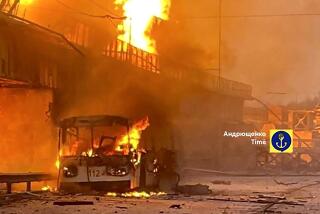Power lines reconnected to Japan’s quake-damaged nuclear plant
- Share via
Reporting from Tokyo — [Update 12:47 a.m.] Tokyo’s utility company says black smoke has been seen emerging from Unit 3 of the crippled nuclear plant in northeastern Japan, prompting a new evacuation of the complex.
Officials with Tokyo Electric Power Co. said Wednesday that workers from the entire Fukushima Dai-ichi plant have been temporarily evacuated.
_________________
Control room lights were on and electronic thermometers were functioning Wednesday at several of Japan’s stricken nuclear reactors, marking small but potentially critical steps toward controlling overheated fuel that has been spewing radiation for more than a week.
Firefighters continued to spray spent-fuel pools and containment vessels with water after connecting power lines late Tuesday to all six reactors at the Fukushima Daiichi plant, about 150 miles north of Tokyo. Control room lights in the troublesome No. 3 reactor, which came on Tuesday evening, could mean crucial functions can be restored to prevent the meltdown of fuel containing highly carcinogenic plutonium.
Tokyo Electric Power Co., or Tepco, which operates the plant, expressed guarded optimism, but it emphasized that equipment still needed to be checked. U.S. observers likewise were hopeful of a turning point in the crisis, which has led to food bans and evacuations.
“They’ve made considerable progress bringing equipment to the plant and restoring power,” said David Lochbaum, director of nuclear safety at the Cambridge, Mass.-based Union of Concerned Scientists. “But they’re not out of the woods yet. They are working with razor-thin margins.”
The volatility of the situation was driven home early Wednesday when work on power repairs at reactor No. 2 was halted because of high levels of radiation, and the temperature at reactor No. 1 was rising to nearly 400 degrees Fahrenheit, prompting renewed efforts to inject water, Kyodo News agency reported. Two workers at No. 2 suffered unspecified injuries, the news agency reported.
Higher-than-legal levels of the radioactive isotopes iodine-131 and cesium-137 were found on more vegetable crops in several prefectures near the nuclear plant, as well as in seawater and raw milk, and shipment bans on produce and milk remained in place. Japanese officials urged consumers Wednesday to not eat a dozen types of vegetables from Fukushima prefecture.
The U.S. Food and Drug Administration on Tuesday banned the importation of milk, milk products and fresh fruits and vegetables from four areas near the plant.
Data released by the U.S. Energy Department on Tuesday showed continued high levels of radiation around the plant. An exposed individual would receive more than a year’s background dose of radiation in two days within some areas inside a 13-mile radius of the plant. An Energy Department team of experts obtained readings of more than 12.5 millirem per hour within the 13-mile proximity, compared with an average background rate in the U.S. of .071 millirem per hour. A millirem is a measure of radiation absorbed by the body.
Farther from the plant, the levels dropped off. At 13 to 25 miles, some readings were about 2.2 millirem per hour, and beyond 25 miles they exceeded about 1.2 millirem per hour. The levels nearest the plant exceed the Environmental Protection Agency’s threshold for intervention to protect public health.
The Energy Department also provided fresh readings on fallout in the U.S., including minute traces of radioactive iodine, tellurium and cesium in Sacramento. Natural sources of radiation are 100,000 times greater than what was measured, the department said.
In the disaster zone, a representative from Tepco who visited people forced to evacuate a 12-mile zone around the plant apologized and said the company was considering offering compensation. No specifics were discussed.
Residents beyond the evacuation zone but within an 18-mile radius of the plant are still being advised to stay indoors. But even beyond that area, residents are struggling with shortages of food, gasoline and medicine.
The U.S. military was continuing to assist in relief efforts in the aftermath of the devastating quake and tsunami, including delivering supplies by helicopter to an elementary school in the hard-hit town of Kesennuma.
As bodies continued to be recovered, Japan’s National Police Agency said Wednesday that the death toll stood at 9,301 with 13,786 missing. Hundreds of thousands of people are in emergency shelters, and freezing temperatures, snow and rain are posing problems for aid workers and the displaced.
Scheduled power outages continued in areas beyond the tsunami zone. With spring arriving and demand for heat waning, Tepco officials said they expected the power shortages to ease, but they are already expressing concern that summer demand could spur more rolling blackouts.
Government officials are preparing to draw up supplemental budgets to finance reconstruction work. Tepco has asked for $18.5 billion in emergency loans to deal with the crippled nuclear plant and power shortages. Damage nationwide has been estimated at about $250 billion.
Times staff writers Thomas H. Maugh II and Ralph Vartabedian in Los Angeles contributed to this report.
More to Read
Sign up for Essential California
The most important California stories and recommendations in your inbox every morning.
You may occasionally receive promotional content from the Los Angeles Times.















